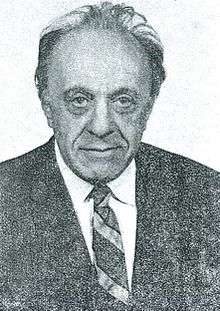Karl Menger
Karl Menger (January 13, 1902 – October 5, 1985) was an Austrian-American mathematician. He was the son of the economist Carl Menger. He is credited with Menger's theorem. He worked on mathematics of algebras, algebra of geometries, curve and dimension theory, etc. Moreover, he contributed to game theory and social sciences.
Karl Menger | |
|---|---|
 | |
| Born | January 13, 1902 |
| Died | October 5, 1985 (aged 83) Highland Park, Illinois, USA |
| Nationality | Austrian |
| Alma mater | University of Vienna |
| Known for | Menger sponge Menger's theorem Distance geometry |
| Scientific career | |
| Fields | Mathematics |
| Institutions | Illinois Institute of Technology University of Notre Dame University of Vienna |
| Doctoral advisor | Hans Hahn |
| Doctoral students | Abraham Wald |
Biography
Karl Menger was a student of Hans Hahn and received his PhD from the University of Vienna in 1924. L. E. J. Brouwer invited Menger in 1925 to teach at the University of Amsterdam. In 1927, he returned to Vienna to accept a professorship there. In 1930 and 1931 he was visiting lecturer at Harvard University and The Rice Institute. From 1937 to 1946 he was a professor at the University of Notre Dame. From 1946 to 1971, he was a professor at Illinois Institute of Technology in Chicago. In 1983, IIT awarded Menger a Doctor of Humane Letters and Sciences degree.[1]
Contributions to mathematics
.jpg)
His most famous popular contribution was the Menger sponge (mistakenly known as Sierpinski's sponge), a three-dimensional version of Sierpinski's carpet. It is also related to the Cantor set.
With Arthur Cayley, Menger is considered one of the founders of distance geometry; especially by having formalized definitions to the notions of angle and of curvature in terms of directly measurable physical quantities, namely ratios of distance values. The characteristic mathematical expressions appearing in those definitions are Cayley–Menger determinants.
He was an active participant of the Vienna Circle which had discussions in the 1920s on social science and philosophy. During that time, he published an influential result[2] on the St. Petersburg paradox with applications to the utility theory in economics; this result has since been criticised as fundamentally misleading.[3] Later he contributed to the development of game theory with Oskar Morgenstern.
Legacy
Menger's longest and last academic post was at the Illinois Institute of Technology, which hosts an annual IIT Karl Menger Lecture and offers the IIT Karl Menger Student Award to an exceptional student for scholarship each year.[4]
Notes
- "Biography of Karl Menger". Illinois Institute of Technology. Retrieved 2010-12-22.
- Menger, Karl (1934-08-01). "Das Unsicherheitsmoment in der Wertlehre". Zeitschrift für Nationalökonomie (in German). 5 (4): 459–485. doi:10.1007/BF01311578. ISSN 1617-7134.
- Peters, O. and Gell-Mann, M., 2016. Evaluating gambles using dynamics. Chaos: An Interdisciplinary Journal of Nonlinear Science, 26(2), p.023103
- "Remembering Karl Menger". Illinois Institute of Technology. Archived from the original on 2009-04-02. Retrieved 2009-03-26.
Further reading
- Crilly, Tony, 2005, "Paul Urysohn and Karl Menger: papers on dimension theory" in Grattan-Guinness, I., ed., Landmark Writings in Western Mathematics. Elsevier: 844–55.
- Golland, Louise and Karl Sigmund "Exact Thought in a Demented Time: Karl Menger and his Viennese Mathematical Colloquium" The Mathematical Intelligencer 2000, Vol 22,1, 34-45
External links
- O'Connor, John J.; Robertson, Edmund F., "Karl Menger", MacTutor History of Mathematics archive, University of St Andrews.
- Karl Menger at the Mathematics Genealogy Project